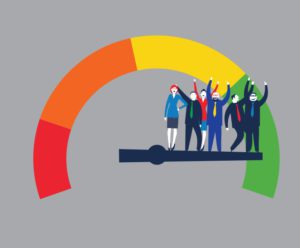
Have you ever clicked on an advertisement or product and been immediately turned off by a lack of interesting content, poor formatting, or a topic that was completely misleading? The sad truth is, this happens a lot. Many retailers focus far too much on getting a person to their website, but not on the value proposition that will lead to a sale.
Think about your product or service. What makes it unique? What are the features that will compel visitors on your website to take action? Why is now the right time for them to purchase?
This is where having a distinct value proposition is essential to your conversion success.
However, it’s not enough to just understand what value you offer to consumers. You need to be able to relay that information in a way that is compelling and that makes your website visitors say “Yes! This is exactly what I’m looking for!”
So how do you achieve that?
Step 1: Ask the Right Question
When crafting your value proposition and trying to achieve that “Yes!” from a customer, the first step is answering one simple question: Why should your ideal prospect buy from you instead of one of your competitors? This might seem like a no-brainer, but you’d be amazed how many retailers ignore this when creating content on their website.
While answering this question, make a detailed list of the specific features and benefits of your offering. For instance, if you sell shoes, what about your shoes sets you apart? Do you offer custom designs? Are they made to accommodate oddly shaped feet? Do they have a built in odor reduction feature? Why would a consumer by your shoes instead of going to Nike, Adidas, or Puma?
Step 2: Understanding Why People Say Yes
Now that you’ve determined what sets you apart, the next step is understanding why people say yes. There are many reasons that a consumer may choose to buy a product. They might like a specific brand or be looking for the lowest price. Perhaps they saw a lot of positive reviews or were recommended by a friend.
What you need to understand is that consumers don’t buy from websites, they buy from people. They don’t want an emotionless experience, they want to know that they are appreciated, that your message will resonate with what’s important to them. The bottom line is, you aren’t optimizing your website, you are optimizing the sequence of thoughts that a consumer goes through while making a purchase decision.
To optimize that sequence of thoughts, you need to guide the user through their internal buying conversation, getting them over each hurdle that could cause them to leave.
- Is it priced right?
- Does it have the color/size/feature that I need?
- Do people like it?
- Does it offer some additional benefit that similar products don’t?
- Do I need it right now?
All of these (and more) are questions that need a “yes” if you are to get that coveted conversion. All of these questions combine to lead to the one final yes, the purchase.
Step 3: Focus on the Right Segment

Your product or service has a distinct target audience. Understanding who it is that you are marketing to is crucial in crafting your value proposition. You need to consider who is the ideal customer that you are targeting and focus your attention on them. This more than likely means you will be neglecting other groups, but that’s not a bad thing! The vast majority of products or services are not made for everyone. If you are selling to everyone, you’ve either got one heck of a product, or else you just haven’t figured out your target market yet.
If this is the case, you need to develop your buyer personas. A buyer persona will have a huge impact on your marketing, as it will help you to analyze your customers, determine patterns, and essentially focus your website to those who are most likely to convert.
Once you’ve identified your segment, it’s time to think big picture.
Step 4: Understanding the 4 Essential Elements of the Value Proposition
There are four factors that determine whether or not a consumer will buy from you:
- Appeal: “I want it!”
- Exclusitivity: “I can’t find it anywhere else.”
- Comprehesion: “I understand what you’re offering and why it’s valuable to me.”
- Authenticity: “I believe in your company and your offering.”
As you begin crafting your value proposition, keep these four considerations in mind. Every single word that you write, or image that is on your page, or call-to-action that you want a consumer to take action on must relate to one of these four elements. If you find that you can’t answer one of these four with any portion of content on a page, get rid of it. It’s not necessary, and it is cluttering up your message.
Step 5: Focus on the Quantitative, Not the Qualitative
One of the major flaws many retailers have when crafting their value proposition is too strong a focus on qualitative statements such as “Leading Provider”, “Award Winning”, or “Best in Class”. The truth is, these terms are virtually worthless in the mind of a consumer. Anyone can claim they are the best. To actually be the best requires more than just fluff statements.
Instead of this approach, focus on quantitative statements that actually impact what you’re selling. Offer up concrete numbers, such as “over five million units sold”, “#1 Retailer in the IR Top 500”, “745 clients worldwide”, or “over 10,000 downloads”. If your product is award winning, show the award badge! If you’ve received some special commendation, be precise about what it is and show verification!
Step 6: Reduce Anxiety on 3 Distinct Levels
 Anxiety is the number one reason that website visitors will leave without making a purchase. So how do you combat anxiety? By using a three-level approach.
Anxiety is the number one reason that website visitors will leave without making a purchase. So how do you combat anxiety? By using a three-level approach.
Level One- Specificity: To reduce anxiety, you must first understand the very specific reasons it arises. Determine the factors that your product or service offers that would be a cause for concern for your customer. Factors such as product or service quality, reliability, price, confidentiality, security, and responsiveness can all be crucial to the buying decision.
Level Two: Location: After understanding what specifically could cause anxiety for a potential customer, it’s time to decide where on your website you can address these concerns. The key here is to identify where in the buying process each of your anxiety factors will pop up, and offer your anxiety reducing solution at that point.
For instance, if price is a major hurdle for your consumer, offering up key features of your product above the price can help to allay fears that someone may be overpaying. If security is an issue, offering up a a secure payment option with third party credibility can reduce anxiety.
Level Three- Risk vs. Reward: Relieving anxiety can be tricky. If you are too intense or too casual with how you position your anxiety solution, you can scare off a customer. This is where a solid testing strategy is in order. Start with a low risk solution to your anxiety factors, and work your way up.
Measure your success on a granular level for each of your anxiety-reducing implementations. Make sure that you aren’t trying to do too much at once. Focus on one specific anxiety factor and optimize your page for that. Once you’re comfortable with the results here, move on to your next factor.
Tying it All Together
Optimizing your value proposition is an ongoing process that requires patience, dedication, and an eagerness to always want to improve and iterate. If you are dedicated to the cause, a strong focus here can have a bigger impact on your conversion rate than virtually any other marketing strategy.
If you are looking for even more information regarding conversion rate optimization, we just released a special report that takes a deep dive into the topic. Get The Q4 Conversion Rate Challenge and discover even more strategies to optimize your website via your value proposition, calls-to-action, testing, and more.




